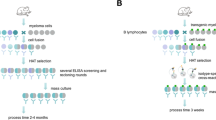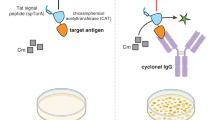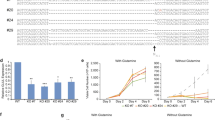Abstract
We report a method for introducing a glutamine synthetase (GS) selectable marker into myeloma cells in which transfectants are selected by growth in a glutamine-free medium. Vector amplification can subsequently be selected using the specffic inhibitor of GS, methionine sulphoximine (MSX). Using this system, DNA sequences encoding a chimeric B72.3 IgG4 antibody were expressed from hCMV-MIE promoters in NSO myeloma cells. A cell line was isolated after a single round of selection for vector amplification which contains approximately 4 copies of the vector, secretes 10–15 pg/cell/day cB72.3 antibody during exponential growth and can accumulate 560 mg/l antibody in a fed-batch air-lift fermentation system. Productivity is stable in the absence of MSX selection.
This is a preview of subscription content, access via your institution
Access options
Subscribe to this journal
Receive 12 print issues and online access
$209.00 per year
only $17.42 per issue
Buy this article
- Purchase on Springer Link
- Instant access to full article PDF
Prices may be subject to local taxes which are calculated during checkout
Similar content being viewed by others
References
Sahagan, B.G., Dorai, H., Saltzgaber-Muller, J., Toneguzzo, F., Guindon, C.A., Lilly, S.P., McDonald, K.W., Morrissey, D.V., Stone, B.A., and Davis, G.L. 1986. A genetically engineered murine/human chimeric antibody retains specificity for human tumor-associated antigen. J. Immunol. 137: 1066–1074.
Nishimura, Y., Yokoyama, M., Araki, K., Ueda, R., Kudo, A., and Watanabe, T. 1987. Recombinant human-mouse chimeric monoclonal antibody specific for common acute lymphocytic leukemia antigen. Cancer Res 47: 999–1005.
Sun, L.K., Curtis, P., Rakowicz-Szulczynska, E., Ghrayeb, J., Chang, N., Morrison, S.L., and Koprowski, H. 1987. Chimeric antibody with human constant regions and mouse variable regions directed against carcinoma-associated antigen 17-lA. Proc. Natl. Acad. Sci. USA 84: 214–218.
Liu, A.Y., Robinson, R.R., Murray, E.D., Ledbetter, J.A., Hellstrom, I., and Hellstrom, K.E. 1987. Production of a mouse-human chimeric monoclonal antibody to CD20 with potent Fc-dependent biologic activity. J. Immunol. 139: 3521–3526.
Beidler, C.B., Ludwig, J.R., Cardenas, J., Phelps, J., Papworth, C.G., Melcher, E., Sierzega, M., Myers, L.J., Unger, B.W., and Fisher, M. 1988. Cloning and high level expression of a chimeric antibody with specificity for human carcinoembryonic antigen. J. Immunol. 141: 4053–4060.
Morrison, S.L. and Oi, V.T. 1984. Transfectomas provide novel chimeric antibodies. Science 229: 1202–1210.
Neumaier, M., Shively, L., Chen, F.S., Gaida, F.J., Ilgen, C., Paxton, R.J., Shively, J.E., and Riggs, A.D. 1990. Cloning of the genes for T84.66, an antibody that has a high specificity and affinity for carcinoembryonic antigen, and expression of chimeric human/mouse T84.66 genes in myeloma and Chinese hamster ovary cells. Cancer Res. 50: 2128–2134.
Bebbington, C.R. 1991. Expression of recombinant antibody genes in non-lymphoid mammalian cells. Methods 2: 136–145.
Wood, C.R., Dorner, A.J., Morris, G.E., Alderman, E.M., Wilson, D., O'Hara, R.M., and Kaufman, R.J. 1990. High level synthesis of immunoglobulins in Chinese hamster ovary cells. J. Immunol. 145: 3011–3016.
Page, M.J. and Sydenham, M.A. 1991. High level expression of the humanized monoclonal antibody Campath-1H in Chinese hamster ovary cells. Bio/Technology 9: 64–68.
Dorai, H. and Moore, G.P. 1987. The effect of dihydrofolate reduc tase-mediated gene amplification on the expression of transfected immunoglobulin genes. J. Immunol. 139: 4232–4241.
Gillies, S.D., Dorai, H., Wesolowski, J., Majeau, G., Young, D., Boyd, J., and James, K. 1989. Expression of human anti-tetanus toxoid antibody in transfected murine myeloma cells. Bio/Technology 7: 799–804.
Gillies, S.D., Lo, K.M., and Wesolowski, J. 1989. High-level expres sion of chimeric antibodies using adapted cDNA variable region cassettes. J. Immunol. Methods 125: 191–202.
Broad, D., Boraston, R., and Rhodes, M. 1991. Production of recom binant proteins in serum-free media. Cytotechnology 5: 47–55.
Cockett, M.I., Bebbington, C.R., and Yarranton, G.T. 1990. High level expression of tissue inhibitor of metalloproteinases in Chinese hamster ovary cells using glutamine synthetase gene amplification. Bio/Technology 8: 662–667.
Meister, A., In: Glutamine Metabolism. Enzymology and Regulation, p. 1–40 Mora, J. and Palacios, R. Eds. . Academic Press, NY.
Kuo, C.F. and Darnell, J.E. 1989. Mouse glutamine synthetase is encoded by a single gene that can be expressed in a localised fashion. J. Mol. Biol. 208: 45–56.
Feng, B., Shiber, S.K., and Max, S.R. 1990. Glutamine regulates glutamine synthetase expression in skeletal muscle cells in culture. J. Cell. Physiol. 145: 376–380.
Eagle, H., Oyama, V.I., Levy, M., Horton, C.L., and Fleischman, R. 1956. The growth response of mammalian cells in tissue culture to L-glutamine and L-glutamic acid. J. Biol. Chem. 218: 607–616.
DeMars, R. 1958. The inhibition by glutamine of glutamyl transferase formation in cultures of human cells. Biochem. Biophys. Acta. 27: 435–436.
Paul, J. and Fottrell, P.F. 1963. The mechanism of D-glutamyltransferase repression in mammalian cells. Biochem. Biophys. Acta. 67: 334–336.
Griffiths, J.B. 1973. The effects of adapting human diploid cells to grow in glutamic acid media on cell morphology, growth and metabolism. J. Cell Sci. 12: 617–629.
Nagle, S.C. and Brown, B.L. 1971. An improved heat-stable glutamine-free chemically defined medium for growth of mammalian cells. J. Cell. Physiol. 77: 259–264.
Whittle, N., Adair, J., Lloyd, C., Jenkins, L., Devine, J., Schlom, J., Raubitschek, A., Colcher, D., and Bodmer, M. 1987. Expression in COS cells of a mouse-human chimaeric B72 3 antibody. Protein Eng. 1: 499–505.
Sanders, P.G. and Wilson, R.H. 1984. Amplification and cloning of the Chinese hamster glutamine synthetase gene. EMBO J. 3: 65–71.
Emtage, J.S., Angal, S., Doel, M., Harris, T.J.R., Jenkins, B., Lilley, G., and Lowe, P.A. 1983. Synthesis of calf prochymosin in Escherichia coli . Proc. Natl. Acad. Sci. USA 80: 3671–3675.
Hayward, B.E., Hussain, A., Wilson, R.H., Lyons, A., Woodcock, V., McIntosh, B., and Harris, T.J.R. 1986. The cloning and nucleotide sequence of cDNA for and amplified glutamine synthetase gene from the Chinese hamster. Nucleic Acids Res. 14: 999–1008.
Subramani, S., Mulligan, R., and Berg, P. 1981. Expression of the mouse dihydrofolate reductase complementary deoxyribonucleic acid in Simian Virus 40 vectors. Mol. Cell. Biol. 1: 854–864.
Cockett, M.I., Bebbington, C.R., and Yarranton, G.T. 1991. The use of engineered E1A genes to transactivate the hCMV-MIE promoter in permanent CHO cell lines. Nucleic Acids Res. 19: 319–325.
Galfre, G. and Milstein, C. 1981. Preparation of monoclonal antibodies: strategies and procedures. Methods. Enzymol. 73(B): 3–46.
Kearney, J.F., Radbruch, A., Liesegang, B., and Rajewsky, K. 1979. A new mouse myeloma cell line that has lost immunoglobulin expression but permits the construction of antibody-secreting hybrid cell lines. J. Immunol. 123: 1548–1550.
Shulman, M., Wilde, C.D., and Kohler, G. A better cell line for making hybridomas secreting specific antibodies. Nature 276: 269–270.
Kilmartin, J.V., Wright, B., and Milstein, C. 1982. Rat monoclonal antibodies derived by using a non-secreting rat cell line. J. Cell. Biol. 93: 576–582.
King, D.J., Adair, J.R., Angal, S., Low, D.C., Proudfoot, K.A., Lloyd, C., Bodmer, M., and Yarranton, G.T. 1992. Expression, purification and characterization of a mouse: human chimeric antibody and chimeric Fab′ fragment. Biochem. J. 281: 317–323.
Cann, A.J., Koyanagi, Y., and Chen, I.S.Y. 1988. High efficiency transfection of primary human lymphocytes and studies of gene expression. Oncogene 3: 123–128.
Kadesch, T. and Berg, P. 1986. Effects of the position of the simian virus 40 enhancer on expression of multiple transcription units in a single plasmid. Mol. Cell. Biol. 6: 2593–2601.
Proudfoot, N.J. 1986. Transcriptional interference and termination between duplicated alpha-globin gene constructs suggests a novel mechanism for gene regulation. Nature 322: 562–565.
Caulcott, C.A., Boraston, R., Hill, C., Thompson, P.W., and Birch, J.R. 1988. The production and purification of monoclonal antibodies, p. 27–42. In: Complementary Immunoassays. W.P. (Ed.). John Wiley and Sons, NY.
Kohler, G. Immunoglobulin chain loss in hybridoma lines. 1980. Proc. Natl. Acad. Sci. USA 77: 2197–2199.
Bell, S.L., Bebbington, C.R., Bushell, M.E., Sanders, P.G., Scott, M.F., Spier, R.E., and Wardell, J.N. 1991. Genetic engineering of cellular physiology, p. 304–306. In: Production of Biologicals from Animal Cells in Culture. Spier, R.E., Griffiths,J.B., and Meignier, B. (Eds.). Butterworth-Heinemann, UK.
Meilhoc, E., Wittrup, K.D., and Bailey, J.E. 1989. Application of flow cytometric measurement of surface IgG in kinetic analysis of monoclonal antibody synthesis and secretion by murine hybridoma cells. J. Immunol. Methods 121: 167–174.
Hendershot, L., Bole, D., Kohler, G., and Kearney, J.F. 1987. J. Cell. Biol. 104: 761–767.
Nakaki, T., Deans, R.J., and Lee, A.S. 1989. Mol. Cell. Biol. 9: 2233–2238.
Weidle, U.H., Buckel, P., and Wienberg, J. 1988. Amplified expression constructs for human tissue-type plasminogen activator in Chinese hamster ovary cells: instability in the absence of selective pressure. Gene 66: 193–203.
Stark, G.R. and Wall, G.M. 1984. Gene amplification. Ann. Rev. Biochem. 53: 447–491.
Pallavacini, M.G., DeTeresa, P.S., Rosette, C., Gray, J., and Wurm, F.M. 1990. Effects of methotrexate on transfected DNA stability in mammalian cells. Mol. Cell. Biol. 10: 401–404.
Author information
Authors and Affiliations
Rights and permissions
About this article
Cite this article
Bebbington, C., Renner, G., Thomson, S. et al. High-Level Expression of a Recombinant Antibody from Myeloma Cells Using a Glutamine Synthetase Gene as an Amplifiable Selectable Marker. Nat Biotechnol 10, 169–175 (1992). https://doi.org/10.1038/nbt0292-169
Received:
Accepted:
Issue Date:
DOI: https://doi.org/10.1038/nbt0292-169
This article is cited by
-
Fluorescence-assisted sequential insertion of transgenes (FASIT): an approach for increasing specific productivity in mammalian cells
Scientific Reports (2020)
-
Expression vector cassette engineering for recombinant therapeutic production in mammalian cell systems
Applied Microbiology and Biotechnology (2020)
-
Comprehensive characterization of glutamine synthetase-mediated selection for the establishment of recombinant CHO cells producing monoclonal antibodies
Scientific Reports (2018)
-
The enhancement of antibody concentration and achievement of high cell density CHO cell cultivation by adding nucleoside
Cytotechnology (2017)
-
Engineering selection stringency on expression vector for the production of recombinant human alpha1-antitrypsin using Chinese Hamster ovary cells
BMC Biotechnology (2015)



